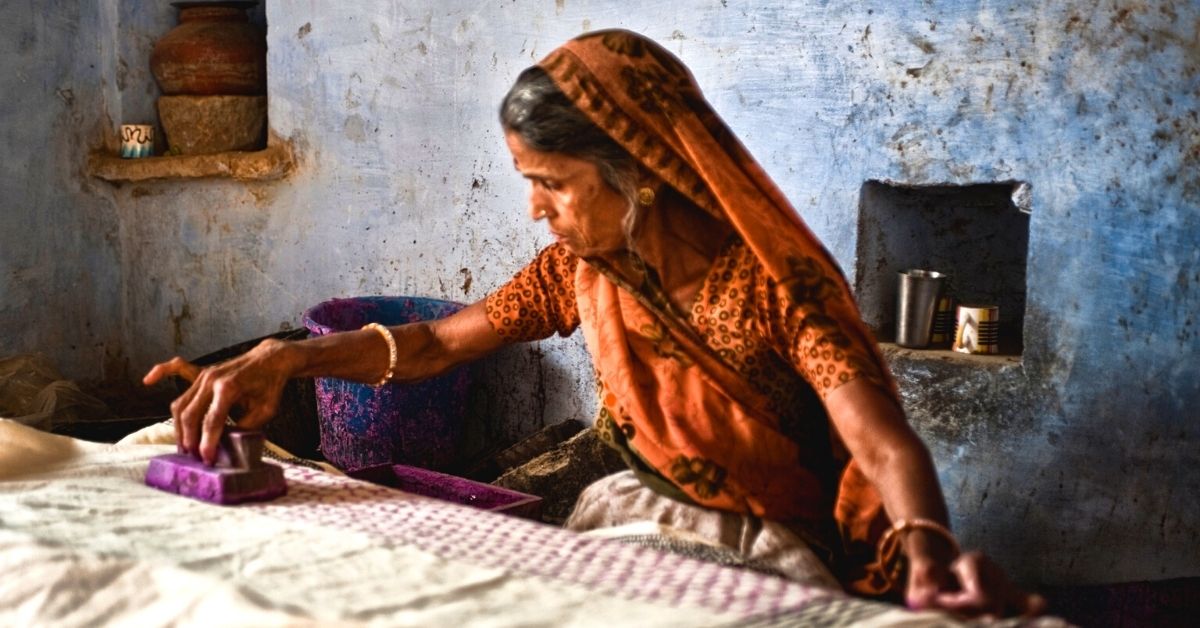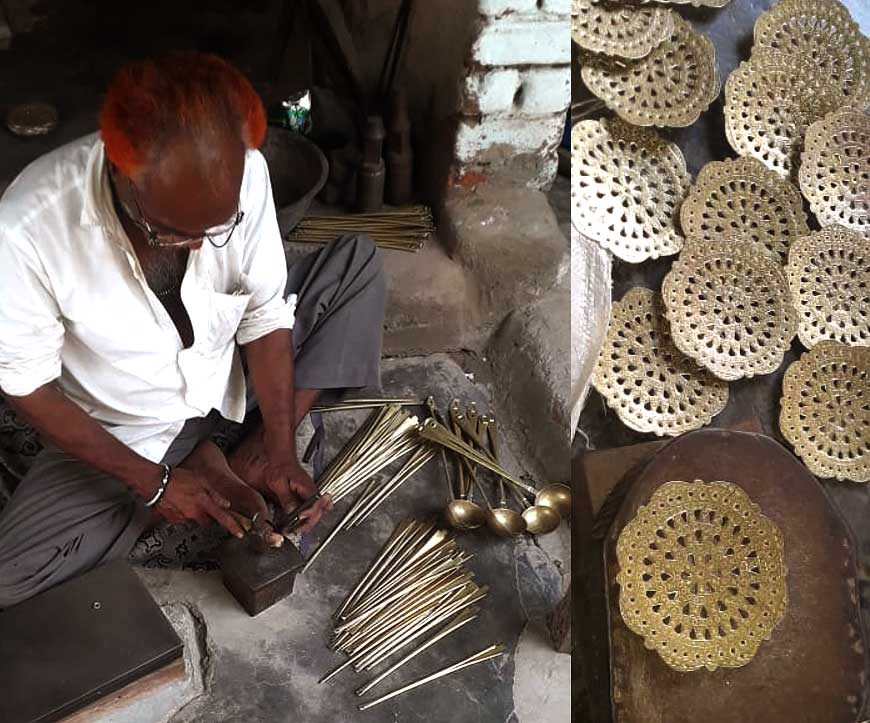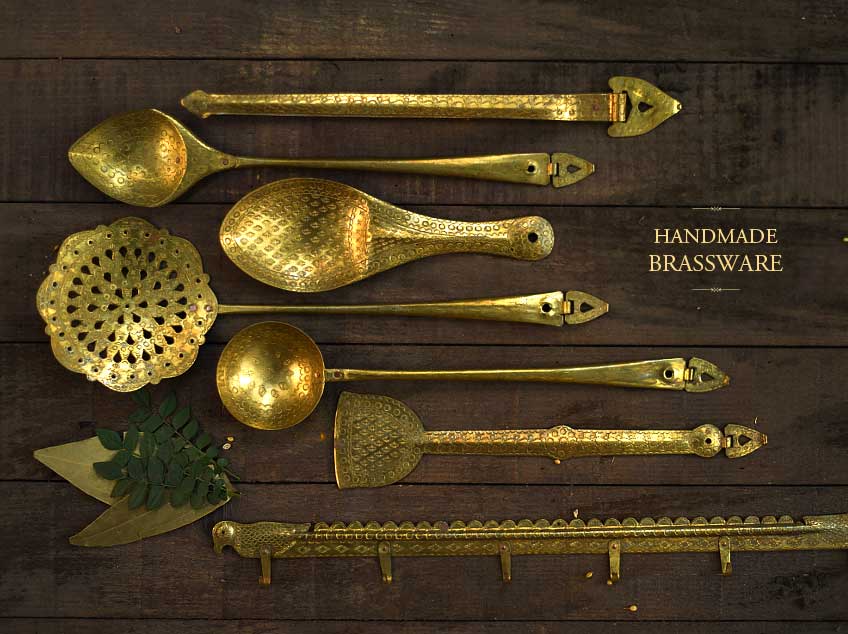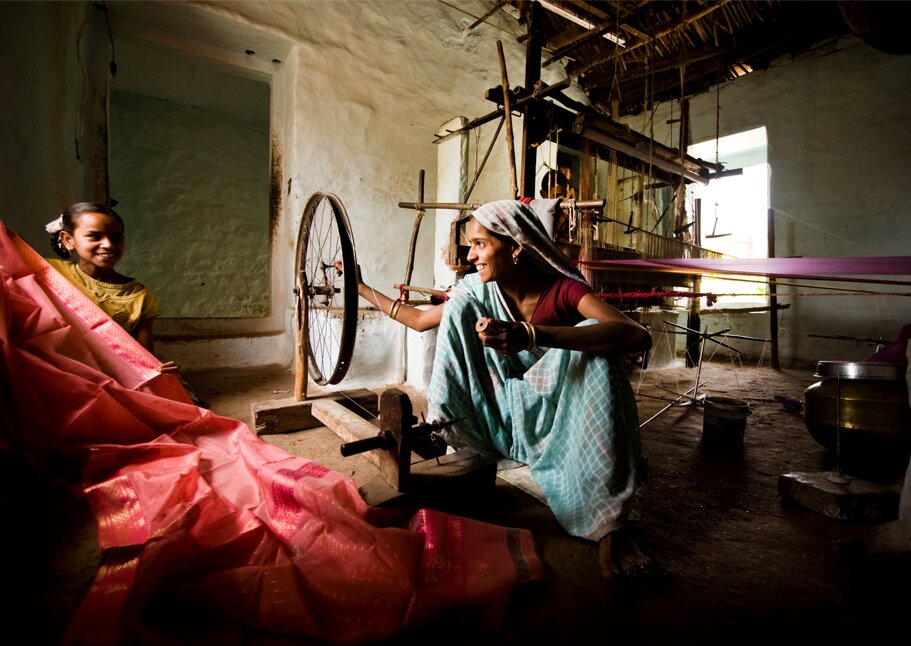3 NID Grads Use Stories to Save Over 250 Dying Crafts & Help 200 Artisans Earn More
Gaatha, an organisation established by three National Institute of Design (NID) graduates, preserves the work of traditional craftspersons by telling their stories, and engaging in in-depth research and archival work.

Back in the early 14th century, a couple of families from a community of nomadic blacksmiths called the Gadia Lohars migrated to Muddarda village in Mehsana taluka, Gujarat. (Image above of an artisan that Gaatha supports)
Coming from Rajasthan, these Gadia Lohar families began using Muddarda village as a base of their operations, from where they would travel on their bullock carts, making metal products and selling them in villages along a predefined route while returning home just once a year.
Starting, the Gadia Lohars were engaged in the business of repairing and making metal tools and utensils for villagers. However, the dawn of the industrial revolution saw people adopting polymer and industrially-made metal products.
This resulted in people giving away or trading their old and discarded metal tools and utensils to these Gadia Lohars as essentially scrap. These blacksmiths would take this discarded metal ware largely comprising brass and copper, melt them and create special utility products like jewellery boxes, lamps, small tables, exquisite kitchenware and treys, among other items.
“We became aware of people’s changing demands and began melting all discarded metal-ware and made products of special utility. Several new techniques were employed to ornament them like punch work, creating patterns with varied hammer marks and etching, among others. Our tools include Eran (anvil), Ghen (heavy hammer), Hathoda (small hammer), Chhini (chisel), Behno (chanpan), Reti (file), Sandasi and Kaglisandasi (pincers), Kutta (holding lever), Loharia (stirrer), Aklai (divider) or Suba (double-hole borer), Chakri (measuring disc),” says Babu Bhai Lohariya, a Gadia Lohar artisan who works with brass, speaking to The Better India.
These items were bought by villagers of a certain economic standing and royal kitchens alike. However, the Lohars began running out of scrap metal given that the old reserves of utensils and other discarded metal were getting exhausted. This turned them on to purchasing brass sheets from Ahmedabad and making items backed by their designs.

Until about 13 years ago, many from the community had left their traditional occupations and transitioned to more financially-viable careers in the cities. While their products once adorned royal kitchens, their works could only be found in museums or obscure craft fairs.
When a craft dies, we not only lose the time-tested techniques but we also lose generations of faith and wisdom that went into making that object. Fortunately, three graduates from the National Institute of Design in Ahmedabad Sumiran Pandey, Shivani Dhar and Himanshu Khatri weren’t willing to let their exquisite work with brass carving wither away into obscurity.
They founded an organisation in 2009 called Gaatha, which preserves the work of traditional craftspersons like the Gadia Lohars through telling their stories in the form of blogs, starting an e-commerce platform for the wares and engaging in in-depth research and archive work.
At any given time 200 artisans from different parts of the country are selling their wares on Gaatha’s e-commerce platform. Besides telling evocative stories through their 800 to 1000-word blog posts, they’ve also documented more than 250 traditional crafts from 15 states.
As Babu Bhai notes, “We have been associated with Gaatha since our encounter with them at a Haat Bazaar in Ahmedabad in 2008-09. Following our partnership, we got a huge response from the market. Working with brass is part of our ancestral heritage. We carve on brass sheets and convert them into a variety of special products. For us, this work is not only about money but also about saving our heritage and craft. Thanks to our association with Gaatha, we earn approximately Rs 45,000 per month from selling our wares on their e-commerce platform.”

From Telling Stories, Selling to Documenting
“My partners and I were students at NID. The institute has always encouraged its students to delve further into traditional craft practices and indigenous knowledge systems. We worked on a book called ‘Handmade in India-Volume II’ in 2007-08 with Professor MP Ranjan and Aditi Ranjan. For the book, we had to study a variety of crafts and arrange them in chronological order, documenting their patrons and other basic information. After graduating in 2007, we started our design studio to support our work by documenting stories behind these crafts and travelling to villages where they were practised. Despite the presence of unique knowledge systems and skills at the time, we are unable to present them properly on digital platforms,” recalls Sumiran Pandya, the co-founder of Gaatha, speaking to The Better India.
For the past 12 years, Sumiran and his partners at Gaatha have been documenting a variety of Indian crafts. When they started, there were two kinds of information on Indian crafts that were available on the internet. The information was either based on a book someone had written or for tourists visiting India. But what they realised was that if you’re buying a piece of art or craft, but don’t know anything about the story or process of making it and the importance to the artisan community behind this particular work, then true appreciation is hard to come by.
“We started by documenting and presenting a variety of Indian crafts on our website with 800 to 1000-word short blog stories. But we later realised the importance of commerce in furthering their craft. Appreciation and giving awards to artisans don’t solve their concerns. They should also be able to sell their product for financial survival,” says Sumiran.
Five years after starting Gaatha, they established an e-commerce platform for these artisans. They claim to do a “thorough screening” for all the products on show here, but of greater importance here is that the people who make these products sell here.
During the peak of the Covid-19 pandemic, when everything was shut down, the people at Gaatha launched their research and archive platform online where they have shared very detailed information on about 115 different traditional crafts from around the country, which students, scholars and craft lovers can access for free (but non-commercial purposes only).

Evolution of Gaatha
Gaatha, a digital presentation of Indian crafts, was started in a bid to do something for these traditional artisans who are vessels for these unique knowledge systems and skillsets. When they started writing these blog posts, an audience for them began to emerge. Over a few years, however, their readers began asking for more information and content on a given craft while simultaneously asking for their products. While artisans like Babu Bhai were appreciative of their work, they also expressed their desire to do business.
“In late 2013, we started an e-commerce platform with an interesting mandate that all products sold on our website will always carry the name of the person/s making them, the village where it’s made and the craft they represent. Before Gaatha arrived on the scene, at events like craft fairs or locations such as fancy boutique stores, traders would never share the name of artisans making these products. On our e-commerce platform, however, we started writing their stories and the names of these artisans, which they appreciated,” claims Sumiran.
During the height of the pandemic, when businesses were shut down, Gaatha launched its research and archive portal. “We are mapping all the clusters of different crafts. Say, you want to find block-print clusters around India, and our platform will show you all of them. You can click on any one cluster and have a detailed 6,000-7,000-word document on each of them,” he adds.
One of the first crafts they documented was Ajrakh, a unique form of block printing found mostly in the Sindh region of Pakistan and the Kutch district in Gujarat. These shawls display unique designs and patterns made using block printing by stamps. Today, many Ajrakh artisans are selling their products through Gaatha. They have also partnered with many weaving-based artisans belonging to Kutch. There are a couple of popular clusters in the region, but no one would visit these smaller clusters. They on-boarded these smaller clusters and today each family is making sales of approximately Rs 30,000-40,000 per month, claims Sumiran.
“Artisans like Babu Bhai never had formal or organised channels of selling their wares. They would sell their products at craft-based melas, exhibitions or other smaller platforms. Thanks to our platform, they don’t have to venture out regularly to sell their wares and can spend more time making their products. During the pandemic, even if they couldn’t venture out, their items did sell on our platform. In Gaatha, 70-75% of the money made from the sale of products goes to the artisans making them. The 25-30% share that we keep is to pay for packaging, maintaining inventory, etc. Say, if a family of artisans is making sales worth Rs 50,000 per month on our platform, they earn at least Rs 35,000 living in their respective villages,” he says.
But everything starts with Gaatha’s research into these different crafts and the artisan communities practising them. They visit the locations irrespective of how remote they are and engage in proper documentation covering 15 different segments of information about the craft and the artisans behind them from their folklores, the stories behind the craft, traditional usage, current usage, the process, tools and materials used, current economic situation, etc.
“During our field visits, we take at least a day to document the information we need. If we believe that a certain kind of craft can do good business on our platform, the artisans are taken on board. If the product isn’t very expensive, we can immediately generate a purchase order and buy it. If it’s a very expensive product, we will try to fix a deal with them saying that we’ll pay them after 15 days to a month. There are a couple of artisans who are well established, and work on consignment. They’ll give us their product, and we’ll pay them after 15 days or a month according to sales generated on our platform. After selecting a product, we do a photoshoot in our studios, while updating our website. There are some artisans who directly courier their products to customers. Here, artisans are also managing their inventory,” he explains.
At any given time, about 200 artisans are always selling their products on the Gaatha platform, of which 50 to 60 sell all through the year. Other artisans, for example, take time to make their wares once the previous batch has sold out. Besides individual artisans, today some organisations are also selling on Gaatha, but they encourage individual artisans.

Respecting Artisans — The Way Forward
Suffice it to say, Gaatha isn’t the only organisation engaged in ‘promoting’ artisans or ‘helping’ them sell their wares. Many have entered the fray. This movement, however, has created its problems. To support artisans, many have started their initiatives without knowing or understanding the craft. This has resulted in the proliferation of duplicate products.
“If you have the requisite knowledge, you will understand the difference between handloom or power loom products, natural dye versus chemical dye or block print versus machine print product, etc. If you don’t understand the craft and saw an opportunity to ‘support’ artisans and do some business, there is a great chance that you’ll encounter duplicate products and not even know it. These products are cheaper and cause problems for genuine makers because of the significant difference in the cost of making them. As a consequence, genuine makers sell their wares at a higher price, but struggle to compete with cheaper duplicates,” says Shivani Dhar.

Looking ahead, Gaatha wants to continue documenting crafts and artisan communities behind them from all over India. They are also looking for some external funding or support to assist with their documentation work. Thus far, they haven’t received any external funding. The money they made from sales is reinvested largely into more research and documentation.
“We have lakhs of skilled artisans but haven’t been able to fulfil their economic potential given that there is a massive market for their work. At the end of the day, it’s about respecting artisans and giving them business. Given the lack of recognition and respect for their work, many of them have left their homes for big cities in search of other work and gave up their crafts. We want to completely reverse this trend before we lose these unique crafts,” he concludes.
(Edited by Yoshita Rao)
Like this story? Or have something to share? Write to us: [email protected], or connect with us on Facebook and Twitter.

Similar Story

Kyani to Nirula’s: Artist Takes India Down Memory Lane with Sketches of Iconic Eateries
Aditya Raj from Jaipur visited an exhibition during his law school days and decided he would be an artist. Here’s his visual representation of a nostalgia trip with pictures of the most iconic eateries in India.
Read more >
If you found our stories insightful, informative, or even just enjoyable, we invite you to consider making a voluntary payment to support the work we do at The Better India. Your contribution helps us continue producing quality content that educates, inspires, and drives positive change.
Choose one of the payment options below for your contribution-
By paying for the stories you value, you directly contribute to sustaining our efforts focused on making a difference in the world. Together, let's ensure that impactful stories continue to be told and shared, enriching lives and communities alike.
Thank you for your support. Here are some frequently asked questions you might find helpful to know why you are contributing?


This story made me
-
97
-
121
-
89
-
167












